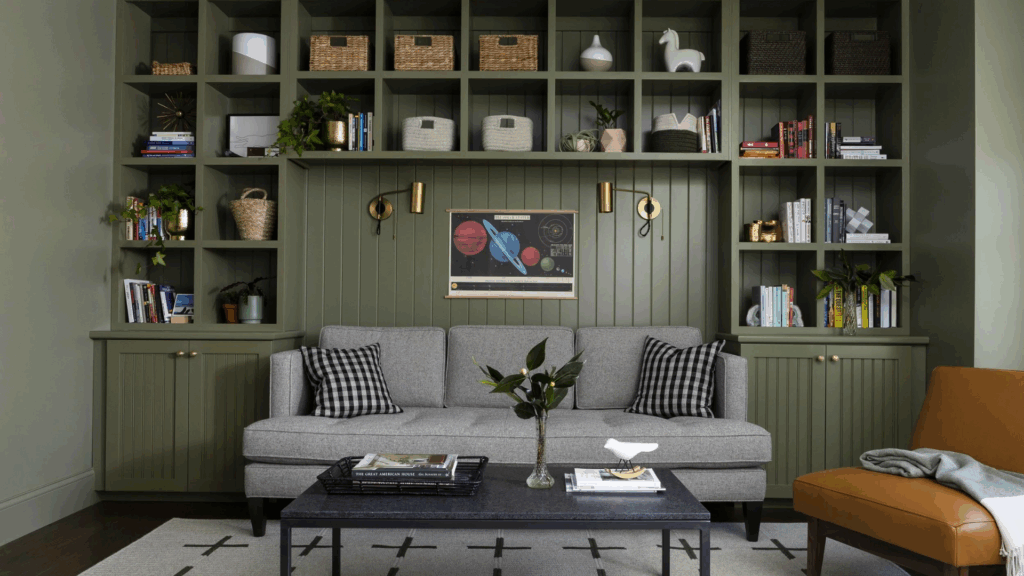Tate Olive is a muted green‑gray paint from Benjamin Moore inspired by garden leaves and moss. This calm shade brings a touch of nature indoors without feeling too dark.
It works in living rooms, bedrooms, kitchens, or even on furniture and doors.
In this post, I’ll examine the color’s background, its warm or cool feel in different lights, and the best spots to use it.
You’ll also find tips on pairing it with whites, woods, or bold accents, plus advice on finishes, from matte walls to easy‑clean satin.
I’ll share photos of real rooms, point out common mistakes, and help you test a sample. By the end, you’ll know if Tate Olive fits your home’s style and feel.
What Kind of Color Is Tate Olive?

If you’re thinking about using Tate Olive in your home, it helps to understand where the color comes from and how it looks in different lighting.
Here’s a closer look at what makes this soft green-gray so easy to use.
Inspiration & Background
Tate Olive takes its name from the soft green of olive trees and garden leaves. Benjamin Moore wanted to show that calm, natural feeling you see in moss-covered stones or shaded paths.
The shade feels gentle and easy, like a quiet garden corner, making it a good choice for spaces where you want to bring a little bit of the outdoors inside.
Hue Profile & Depth
This color blends green with just enough gray to keep it soft and not too bright. That mix helps Tate Olive feel fresh but also settled.
In strong daylight, its green side becomes more noticeable; in dim light, the gray part stands out more. The result is a warm, natural color that fits in many kinds of rooms without feeling bold or too heavy.
Tate Olive is the kind of color that stays calm and steady no matter where you use it. If your room gets lots of sun or stays shaded, this shade adjusts well and gives off a peaceful, balanced look.
Is It a Warm or Cool Color?
Tate Olive balances right between warm and cool because it mixes green with soft gray. That gray base keeps the green from feeling too bright or too cold, giving the color a gentle, steady look.
In strong daylight, the green side of the Tate Olive comes forward, looking fresh like new leaves. Under warm lamps or in shaded corners, the gray tone shows more, making it feel a bit cooler and more faded.
Because of this change, the same wall can look different in the morning sun than it does in the evening by lamplight. To make sure you like how it changes, paint a small patch and watch it throughout the day.
What Paint Finish Should You Choose?
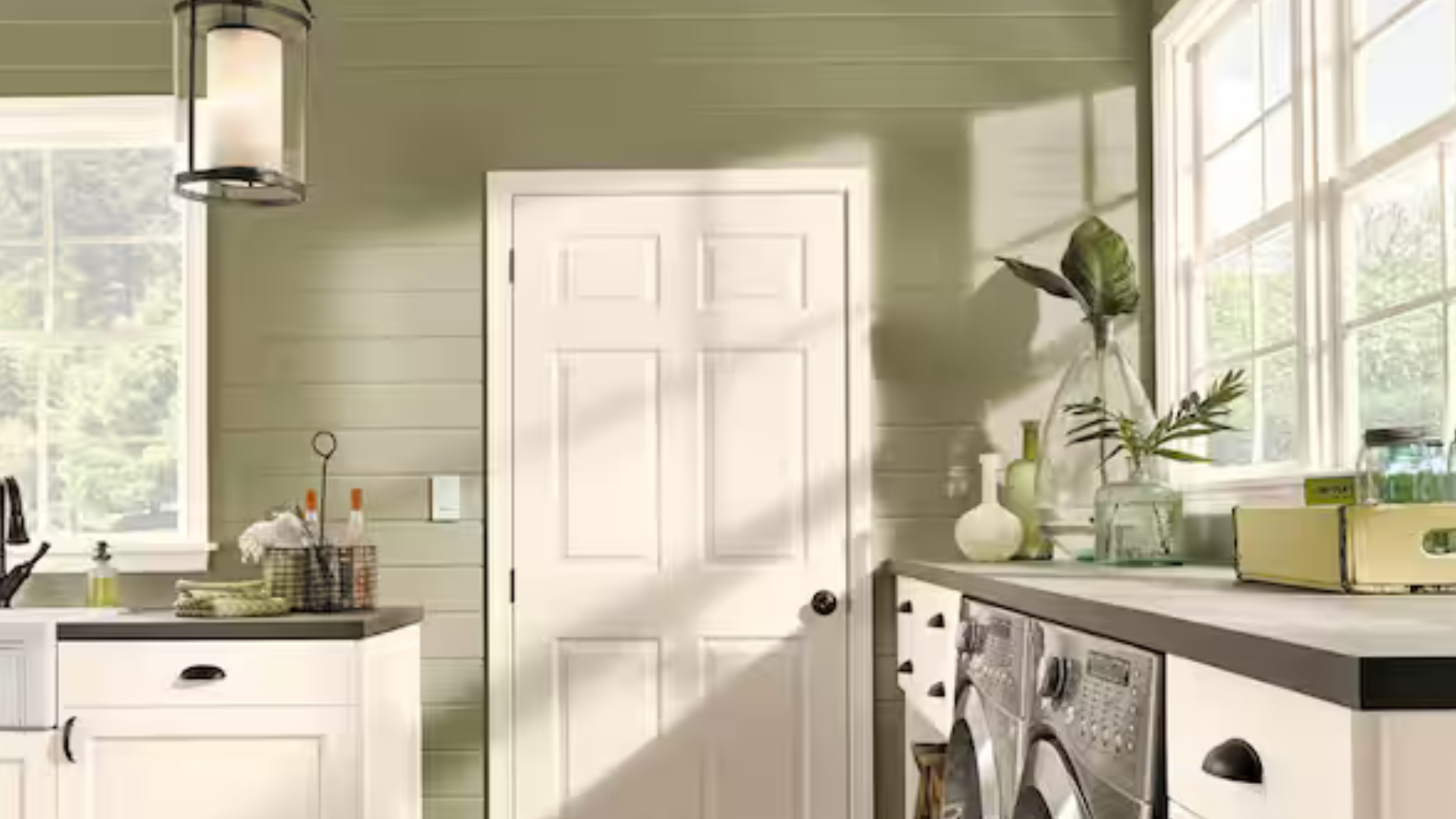
Picking the right finish can help your paint job look better and last longer. Tate Olive works well with different finishes depending on where you’re using it.
Matte vs. Eggshell
Matte finish has almost no shine, so it helps cover up little bumps, dents, or roller marks on the wall. It’s a good choice for spaces like adult bedrooms, dining rooms, or walls that don’t get touched a lot.
It gives the wall a soft, flat look that feels calm and even. However, matte paint can be harder to clean if it gets marked or smudged.
The eggshell finish has just a little shine, not enough to be shiny, but enough to bounce a bit of light around the room.
It’s easier to clean than matte, so it’s a better pick if you need to wipe off fingerprints or smudges now and then.
This makes it great for living rooms, hallways, or rooms with kids or pets. It still feels soft but holds up a bit better with use.
High‑Traffic Areas
In areas like kitchens, kids’ bedrooms, or hallways, walls get touched more and are more likely to get messy. For these places, it’s better to choose a stronger finish like eggshell or satin.
These finishes don’t wear out as fast, and you can clean them with a damp cloth without rubbing off the color.
Satin has a bit more shine than eggshell and is often used for doors, cabinets, or trim. It works well where you want a clean, smooth surface that’s easy to care for.
If you’re painting a quiet room where the walls won’t get touched often, matte can still be a great choice. It gives a soft look and helps hide small flaws in the wall surface.
Choosing the right finish for each part of your home helps Tate Olive look its best. Think about how often a space gets used and how easy you want cleaning to be.
With the right choice, your walls and trim will stay neat and look good for years.
Real Home Ideas Using Tate Olive
Tate Olive is a soft, earthy green that works well in many parts of the home.
Living Room Inspiration
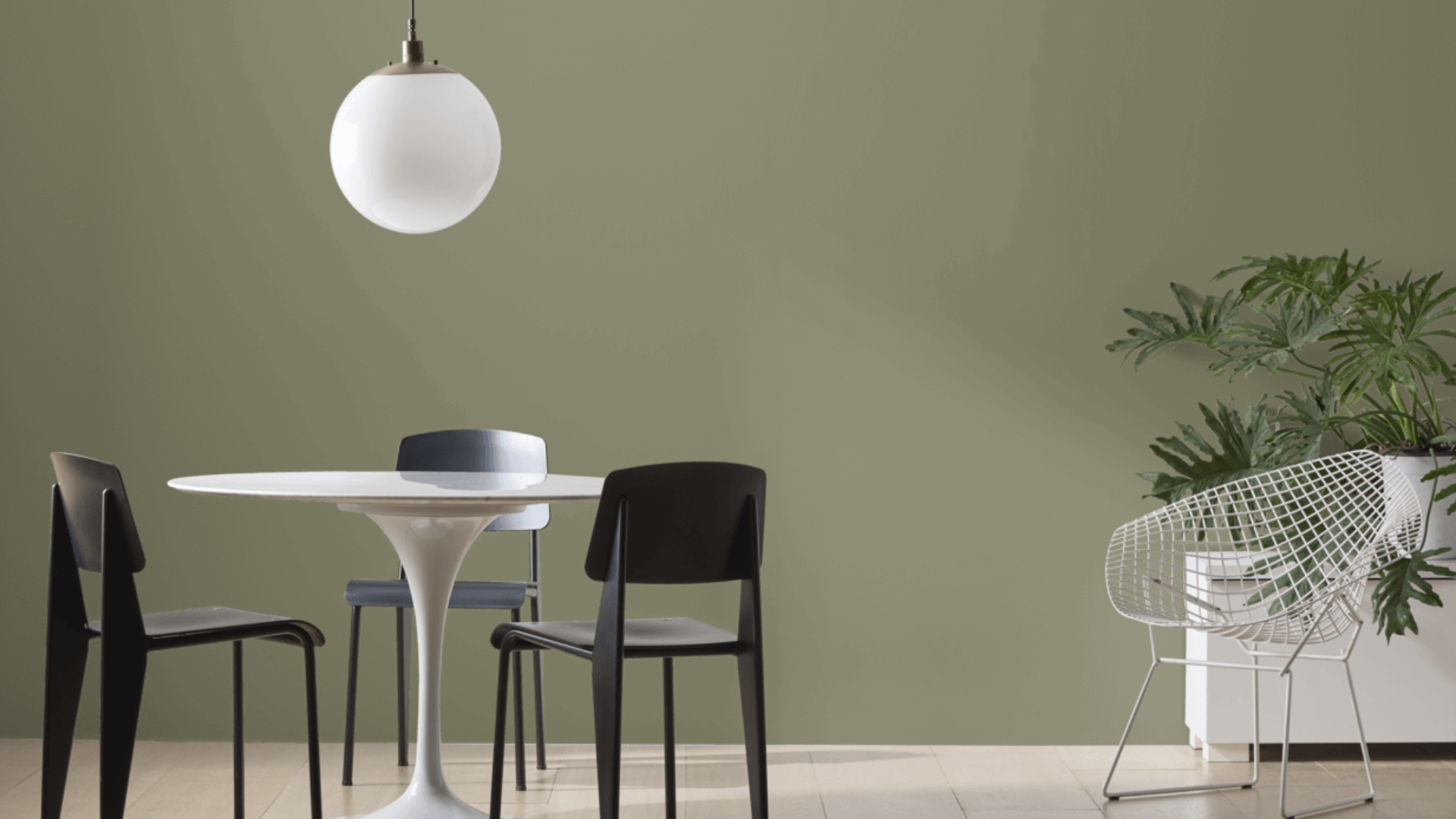
Try painting one wall behind the sofa in Tate Olive. It creates a calm background without taking over the space. To balance the green-gray, add light-colored pillows and a cream rug.
I painted the back panel of my built-in shelves in Tate Olive and kept the fronts white. The soft green peeks through behind books and small decor, making everything pop without overwhelming the space.
Kitchen
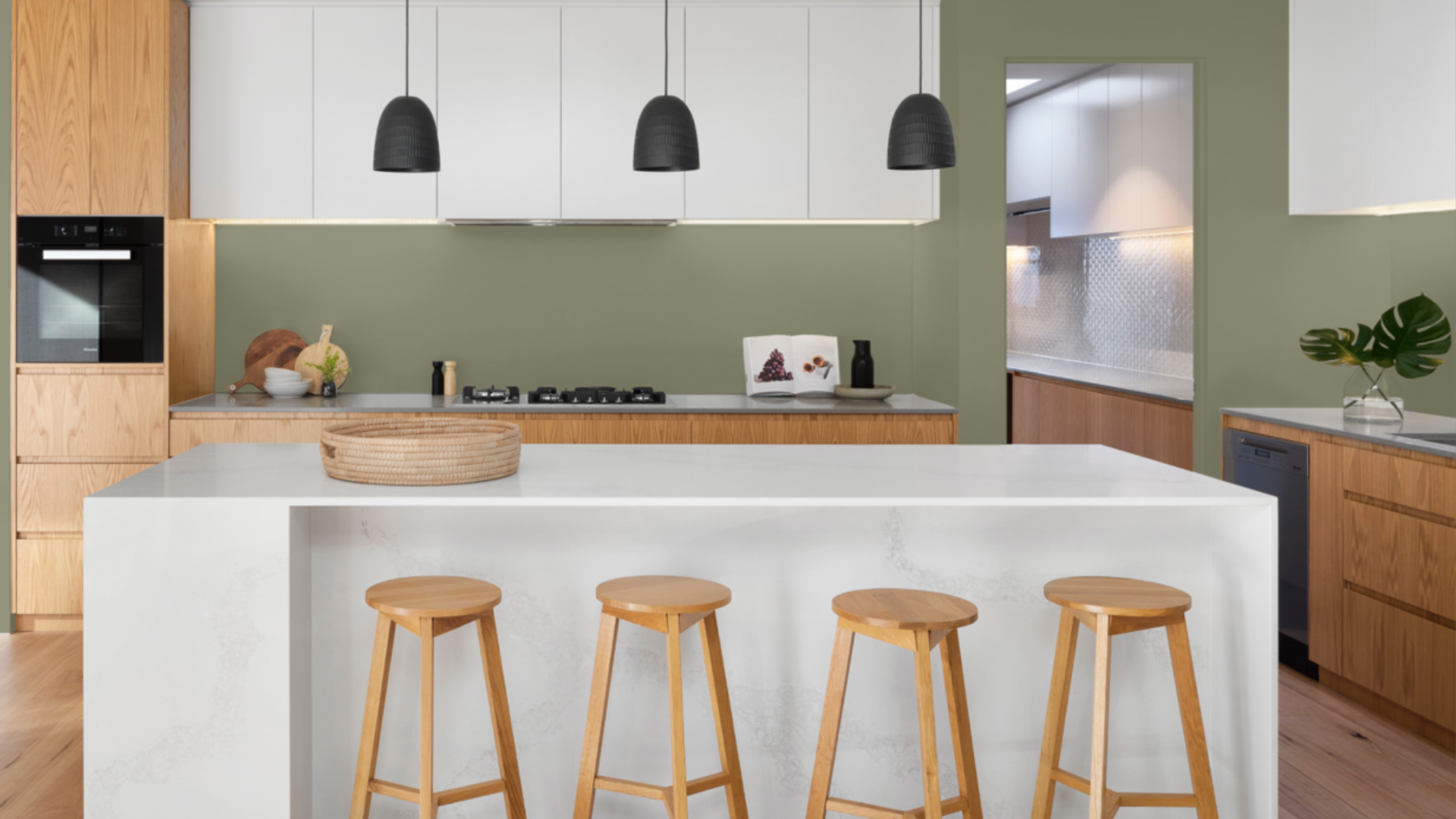
Paint your lower kitchen cabinets in Tate Olive to give them a fresh look. Use a satin finish so you can clean up spills easily. Keep your upper cabinets or walls in a soft cream or light white to make the room feel open.
For something small, paint just your pantry door in Tate Olive and leave the frame white. It adds interest without needing to change everything else.
Bedroom Accent Wall
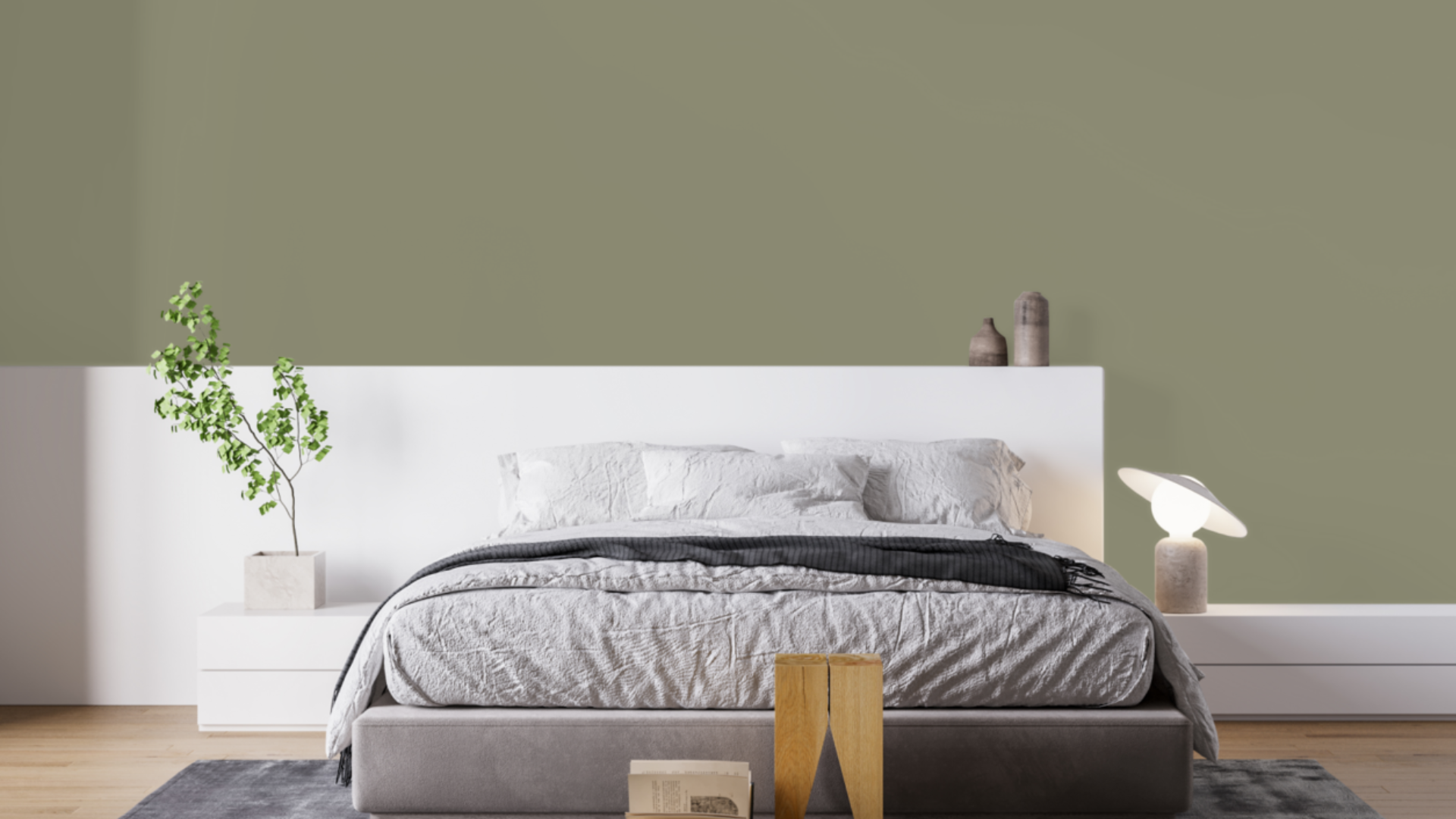
In my bedroom, I painted the wall behind the bed in Tate Olive to create a calm, grounded feeling. This soft green-gray brings a restful atmosphere that makes it easier to unwind at the end of the day.
It pairs beautifully with crisp white bedding and natural wooden side tables, creating a balanced and cozy space. The color adds depth without making the room feel dark or heavy.
For a simple update, you could even paint a dresser or wardrobe in this shade to introduce a quiet, natural touch that ties the whole room together.
Mistakes to Avoid
Tate Olive is a calm and natural-looking color, but how and where you use it matters. I’ve made these mistakes myself and they just end up giving you a headache, so its best to avoid them from the beginning.
- Skipping the Sample Patch: Always test Tate Olive on your wall before painting a full room. Paint a small square and check it during different times of day, like in morning sun, afternoon shade, and under lamp light at night.
- Using Too Much in Small Rooms: Painting all four walls in a deep color can make a small room feel tighter. If the space is already small, try using Tate Olive on just one wall or only on the bottom half of the wall with a lighter shade above.
- Using the Wrong Finish in the Wrong Spot: Shiny finishes like gloss can show every flaw, like bumps, cracks, or brush marks. On uneven walls, this can make the paint look rough. Save shinier finishes for doors, trim, or cabinets where you need easy cleaning.
A little planning goes a long way. By testing your color, using it wisely in small spaces, and picking the right finish, Tate Olive will look its best and make your home feel calm, clean, and well put together.
Conclusion
Tate Olive is a soft green‑gray that brings a calm, natural feel to any room. I’ve looked at what it is, which colors and styles work well with it, and where to use it, from walls to furniture to the front door.
This shade blends green with a touch of gray, making it feel steady and grounded without being too bright or too dark.
Remember to test a small patch first and check it at different times of day to see how the color changes in sunlight and indoor lighting.
In smaller rooms, use Tate Olive on one wall or the lower part of the wall with a lighter color above to keep the space feeling open.
Choose a flat finish like matte for walls with small marks or uneven spots, and go with eggshell in areas like kitchens or hallways where surfaces need to be cleaned more often.
With these simple steps, you’ll feel ready to use Tate Olive and enjoy a clean, peaceful look that fits right into your home.

